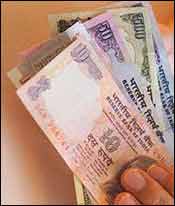Home > Business > PTI > Report
Re touches record high vs US$
Swithin Fernandes in Mumbai |
December 30, 2003 16:16 IST
 Year 2003 will go down in the history of Indian currency markets, as one in which the rupee notched up the highest-ever recorded gains on the back of sustained robust trade and capital inflows, helped largely by a falling US dollar vis-a-vis major global units, mainly the euro.
Year 2003 will go down in the history of Indian currency markets, as one in which the rupee notched up the highest-ever recorded gains on the back of sustained robust trade and capital inflows, helped largely by a falling US dollar vis-a-vis major global units, mainly the euro.
Following a modest 0.52 per cent rise last year, the first appreciation in a decade, the rupee ruled generally firm for most part of the current calendar year and has risen by around 7.68 per cent since May 16, 2002 when it plunged to life-time lows of Rs 49.08 a dollar.
Click here to take today's poll
It has ended the year at a 39-month peak at Rs 45.5800/5850 per dollar (December 26), a whopping gain of Rs 2.42 from the previous year's closing levels of Rs 48.00/01.
Burgeoning foreign exchange reserves that crossed the $100 billion mark, rising exports, foreign institutional investments into the booming stock markets and expatriate remittances were the main factors behind the robust strength of the rupee.
Although, the rupee has appreciated sharply by over 5.32 per cent, it was still undervalued by around 2 per cent against the greenback on a trade-weighted basis, given the steep fall of the dollar to multi-year lows against its major global rivals, particularly the euro.
The US dollar has lost 17 per cent against euro, 8 per cent against the pound sterling and 10 per cent vis-v-vis the Japanese yen in the last 12 months.
Meanwhile, the rupee declined sharply by 11.35 per cent against euro, tumbled by 6.13 per cent against the Japanese yen and dipped by 4.38 per cent against the British sterling, following the dollar's slide against these units owing to US' steep current account deficit and a slow economic recovery.
 Backed by good growth in exports and strong recovery in agriculture, the Indian economy could grow beyond seven per cent, Reserve Bank of India Governor YV Reddy said in November. The industrial sector would most likely grow at six per cent in the current fiscal.
Backed by good growth in exports and strong recovery in agriculture, the Indian economy could grow beyond seven per cent, Reserve Bank of India Governor YV Reddy said in November. The industrial sector would most likely grow at six per cent in the current fiscal.
Global rating agency, Standard & Poor's also revised, in mid-December, India's long-term foreign currency rating from "negative" to "stable" on the back of improving external finances.
RBI continued with its soft interest rate regime and announced a 0.5 per cent reduction in interest rates on saving account to 3.5 per cent, slashed the repo rate by 50 basis points to five per cent from 5.50 per cent with effect from March 3. Later, the bank again reduced the repo rate to 4.50 per cent from 5 per cent.
The interbank foreign exchange (forex) market was by and large stable with the central bank keeping a close watch on activities, intervening at any given time to curb excessive speculation and volatility.
On October 16, the RBI capped NRE (Non-resident external) deposit rates to upto 25 basis points over LIBOR or swap rate for the dollar in order to reduce the influx of forex through arbitrage opportunities.
The central bank later came out with new external commercial borrowings norms to effectively eliminate another major source of dollar inflows.
Notwithstanding the curbs to reduce forex inflows from questionable sources, the rupee continued its north-bound journey and barring the occasional blips, sentiments remained positive, even as the gains were gradual, thereafter.
The first quarter (Jan-Mar) was quiet with the rupee showing a steady upward move and traded in a range of Rs 47.98 and Rs 47.70, overcoming temporary setbacks following the US invasion of Iraq.
April to June period saw the rupee breach key resistance levels on its way to new highs.
The rupee traded in a range of Rs 47.98 and Rs 46.40 in the second quarter of the year. It spurted to an over 28-1/2 month closing peak of Rs 46.3950/4050 in mid-June.
Continuing its steep north-bound journey in the third quarter -- July to September -- the rupee climbed to new peaks frequently on the back of persistent heavy forex inflows and a lingering weak dollar.
The domestic currency moved in a range of Rs 46.48 and Rs 45.70, piercing through crucial support levels on its north-bound sojourn.
Rupee underwent a downward correction in November after RBI initiated new ECB norms, which effectively eliminated another major source of dollar inflows. State Bank of India's $5.5 billion Resurgent India Bonds redemption pressures passed off smoothly, but dented the rupee's value, causing a cash dollar shortage in the system and rupee declined by 52 paise in ten straight sessions to November 10. It tumbled to Rs 45.88/89 on Novemger 24 and turned forward dollar premiums into discounts across the board.
The last month of the year saw the rupee bounce back, aided by a ten-session smart rally to touch Rs 45.51/52, before settling around Rs 45.5800/5850 on December 26, dragged down by month-end pressures.
A majority of business chieftains in the country expects to end the current financial year with a growth of at least ten per cent, according to a snap poll conducted by Confederation of Indian Industry.
With upbeat sentiments prevailing, traders expect the rupee to consolidate in the New Year.